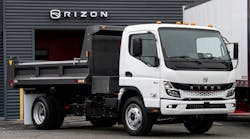The concept of spec’ing new tires with shallower-than-typical tread depth for trailer and drive axle positions on a commercial vehicle might be considered anathema to many fleets – largely because starting with less tire tread results in getting fewer miles before tire removal, thus increasing a tire’s cost per mile.
But if such shallower-than-typical tread resulted in higher fuel efficiency, is that trade-off worth it? Put another way, would the resulting gain in overall tractor-trailer fuel economy not only recoup the higher cost-per-mile associated with running shallower tread tires for a fleet, but return more money on top of that from the fuel savings?
Guy Walenga, director of engineering for Bridgestone Americas Tire Operations (BATO), for one believes that many fleets could potentially save more money in the long-run by engaging in a “less-tire-mileage-more-fuel-economy” trade-off – and he’s currently chairing a Technology & Maintenance Council (TMC) committee that’s going to try and prove it.
“The problem has always been that tire cost-per-mile and fuel economy typically represent two separate sets of operational data within any fleet – and they don’t always ‘talk’ to one another,” he explained in an interview with Fleet Owner during a media event organized by Bridgestone Commercial Solutions (BCS) at its North American Manufacturing Education Center attached to its LaVergne Firestone truck tire facility.
“So the question we’re now asking is this: if we give back on tire mileage to gain better fuel economy, will the fuel savings make up for it?” he explained. “At this time, with diesel averaging nearly $4 a gallon in the U.S., we think it will.”
Manufacturers like Bridgestone and others already make fuel efficient truck tire models. Indeed, one of the features of Bridgestone’s new Ecopia tire line unveiled earlier this year – tires designed specifically to offer better fuel economy through lower rolling resistance – is that they weigh two pounds less than comparative Bridgestone OTR tires due to a new sidewall structure.
Initial tread depth, however, represents the next step in the tire fuel economy equation within trucking, said Walenga. “We’ve known for a long time that the fuel economy performance of a tire improves over time – largely as the tread begins to wear down,” he pointed out. “The question is can we cost-justify starting out with a lower-than-normal tread depth from the start.”
Walenga noted that improving the low rolling resistance characteristics of truck and trailer tires – both when new and as retreads – is the key piece of the puzzle, as a 5% improvement in rolling resistance equates to a 1% gain in fuel economy.
“If you maintain proper tire air pressure, you’ll get the lowest rolling resistance and thus the best fuel savings – as well as help preserve the tire casing for reuse as a retread,” he stressed. “That ensures that fleets don’t leave money on the table when it comes to tire management.”
Walenga also feels fleets don’t necessarily have to engage in expensive testing to prove out the fuel savings from using shallower tread tires, either. Indeed, he believes than rather try to eliminate variables in a “controlled” test a fleet can simply operate 10 similarly-spec’d tractor-trailers – with five using the fleet’s current tire models and five with the shallower tread variety – for six months and then compare the fuel economy numbers.
“We all know there are tremendous variances in truck operations – road conditions, geography, weather, load weight, altitude, and especially the driver behind the wheel,” Walenga said. “Indeed, drivers alone can ‘swing’ fuel economy by as much as 35% one way or the other based on how they operate the vehicle.”
Instead, he thinks leaving all those variables in place for both sets of trucks should help average out fuel economy performance over time – and give fleets a reasonably good indication of whether they’ll gain enough in fuel efficiency to exceed the higher cost-per-mile of shallower tires.



